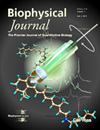微管的分支、交联和分散加速了细胞内的组装
IF 3.1
3区 生物学
Q2 BIOPHYSICS
引用次数: 0
摘要
细胞分裂前,有丝分裂纺锤体由染色体和中心体组装而成。细胞分裂后,高尔基细胞器由分散在子细胞中的多个囊泡聚集而成。这些是动态微管使囊泡、细胞器和染色体在细胞内组装成为可能的许多其他例子之一。最突出的微管网络是“搜索”囊泡和染色体的以中心体为中心的微管,但也有来自囊泡和染色体的微管,这就提出了多个微管网络之间的协调是否优化了组装过程的问题。本研究使用计算模型来研究微管动力学如何影响囊泡中细胞器的组装。该模型包括两个微管种群:锚定在囊泡上的微管,驱动局部聚集;锚定在中心体上的“中心”微管,使囊泡全局聚集。模拟表明,微管分散化——两个微管种群的平衡贡献——加速了数十个囊泡的组装,但将所有微管分配给数百个囊泡则优化了组装。定向偏置的微管生长,特别是在避免自发突变事件的情况下,进一步加速了组装。此外,当微管分支以最佳角度和间距出现时,可以提高装配效率。最后,重叠的中央微管和“局部”微管的快速交联可以大大加速组装。将这一模型应用于早期有丝分裂的纺锤体组装,揭示了类似的见解。该模型表明,当分子资源有限时,观察到的多个微管网络优化了细胞内组装过程。本文章由计算机程序翻译,如有差异,请以英文原文为准。
Branching, crosslinking and decentralization of microtubules accelerates intracellular assembly
Before cell division, mitotic spindle is assembled from chromosomes and centrosomes. After the cell division, Golgi organelles assemble from multiple vesicles scattered across daughter cells. These are among many other examples of intracellular assembly of vesicles, organelles and chromosomes made possible by dynamic microtubules. The most prominent microtubule networks are centrosome-focused asters that ‘search’ for the vesicles and chromosomes, but there are also microtubules originating from the vesicles and chromosomes, raising the question whether a coordination between multiple microtubule networks optimizes the assembly process. This study uses a computational model to examine how microtubule dynamics influence the assembly of organelles from vesicles. The model includes two microtubule populations: microtubules anchored to the vesicles, which drive local clustering, and ‘central’ microtubules anchored to the centrosome that aggregate the vesicles globally. Simulations show that a microtubule decentralization – balanced contribution from both microtubule populations — accelerates the assembly of tens of vesicles, but that assigning all microtubules to hundreds of vesicles optimizes the assembly. Directionally biased microtubule growth, particularly when avoiding spontaneous catastrophe events, further accelerates the assembly. Additionally, microtubule branching, when occurring at optimal angles and spacings, enhances the assembly’s efficiency. Lastly, rapid crosslinking of overlapping central and ‘local’ microtubules can drastically accelerate the assembly. Applying this model to the spindle assembly in early mitosis reveals similar insights. The model suggests that the observed multiple microtubule networks optimize the intracellular assembly processes when molecular resources are limited.
求助全文
通过发布文献求助,成功后即可免费获取论文全文。
去求助
来源期刊

Biophysical journal
生物-生物物理
CiteScore
6.10
自引率
5.90%
发文量
3090
审稿时长
2 months
期刊介绍:
BJ publishes original articles, letters, and perspectives on important problems in modern biophysics. The papers should be written so as to be of interest to a broad community of biophysicists. BJ welcomes experimental studies that employ quantitative physical approaches for the study of biological systems, including or spanning scales from molecule to whole organism. Experimental studies of a purely descriptive or phenomenological nature, with no theoretical or mechanistic underpinning, are not appropriate for publication in BJ. Theoretical studies should offer new insights into the understanding ofexperimental results or suggest new experimentally testable hypotheses. Articles reporting significant methodological or technological advances, which have potential to open new areas of biophysical investigation, are also suitable for publication in BJ. Papers describing improvements in accuracy or speed of existing methods or extra detail within methods described previously are not suitable for BJ.
 求助内容:
求助内容: 应助结果提醒方式:
应助结果提醒方式:


